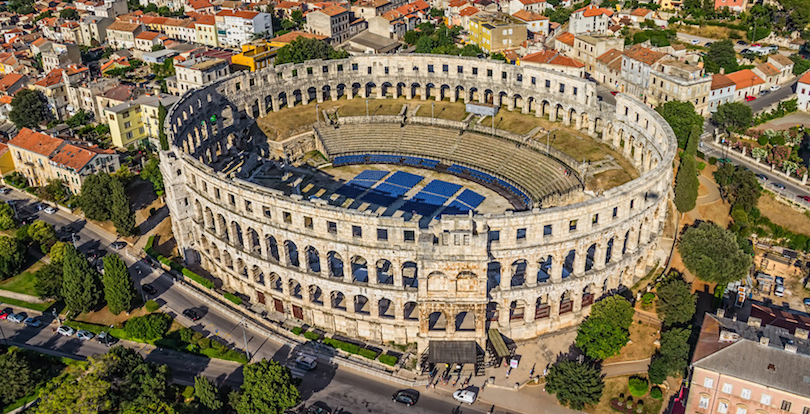
The magnificent amphitheater of Pula as it exists today.
Posted on 03/30/2017 12:57:46 PM PDT by Antoninus
Before us rose the three tiers of the amphitheater, of snowy marble, but then reflecting the western rays of a cloudless April evening, and arrayed in a vesture of pink like a sunset Alp....
“Oh, what perfect loveliness and peace!” said I to an Istrian priest who resided in the city, and who had come aboard at Rovigno.
“And yet what different associations that amphitheater gives,” he replied....
The above snippet is taken from John Mason Neale's novella, The Daughters of Pola: Family Letters Relating to the Persecution of Diocletian which is about to be republished after being generally unavailable for over a century. Written in 1861, this little gem of a book is a great way to introduce the present generation of readers to an aspect of history that is often downplayed or purposely ignored—namely the eight years of empire-wide persecution of Christians by the Roman government in the early 4th century AD.
The climax of The Daughters of Pola takes place here. This is important because even among fairly erudite people today, there is a strong undercurrent of revisionist disbelief regarding the persecutions. Some critics will even go so far as to deny that persecutions happened at all, claiming that they were completely made up by later Christian historians.
Anyone who has actually studied the existing primary sources knows well that the persecutions are matters of historical fact. Sadly, the literature of that age, though extant, is often hard to access for modern readers. The critics are right to the extent that many of the numerous martyrdom stories that have come down to us from that age were greatly embellished by later copyists, to the point that the truth behind them is obscured or even lost. However, numerous authentic histories exist, including detailed legal transcripts taken by pagan Roman officials describing the investigations and trials of unrepentant Christians. I have attempted to collate a few of these accounts here on this blog, such as the following:
The burning of Christian scriptures by the Roman government,
The martyrdom of Saint Crispina,
Saint Pontius the Deacon's account of the martyrdom of Saint Cyprian of Carthage,
The Passion of Saints Perpetua and Felicitas,
The martyrdom of Saint Polycarp,
The escape of the confessor Saint Felix.
In The Daughters of Pola, John Mason Neale tells a story that echos all of the above accounts. Trusting his vast erudition as a classicist and scholar of ancient languages, Neale successfully created a narrative from a sequence of letters among the characters. In tone, some of the letters sound uncannily like those of Ausonius whose works have come down to us from the later 4th century. Neale set his tale in the Roman city of Pola (modern day Pula in Croatia), whose fantastically preserved Roman ruins exist to this day. Indeed, the climax of the novel takes place in the magnificent amphitheater of Pola, whose size and state of preservation rivals even the great Colosseum in Rome, as can be seen in the photo above. And indeed, we know of at least one martyrdom that took place in this amphitheater, namely that of Germanus in AD 284.
So while a work of fiction itself, The Daughters of Pola makes for a brief, accessible and beautifully crafted introduction to the authentic sources for modern readers. The novella successfully captures the sound and feel of late antiquity, exploring the tensions that the rise of Christianity and its official condemnation introduced into Roman families and society. As such, it provides a realistic window into the late Roman world when paganism launched its final, furious campaign to crush Christianity, and when the blood of the martyrs led directly to the complete triumph of the Christian faith within a generation.

In a footnote of history, Pula was the home port of the KUK Kriegsmarine, the Austro-Hungarian Navy. It was Captain Von Trapp’s post until the Navy was disbanded and he resettled his family in Salzburg.
Catholic ping!
It’s in remarkable condition. Is it still used for any purpose?
Disclaimer: Opinions posted on Free Republic are those of the individual posters and do not necessarily represent the opinion of Free Republic or its management. All materials posted herein are protected by copyright law and the exemption for fair use of copyrighted works.